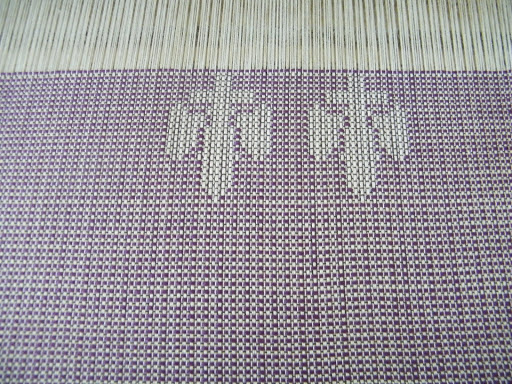I’ve decided that it’s time to tackle a project that is quite challenging and that has been on my bucket list for awhile.
A couple of years ago my guild study group project was to explore Diversified Plain Weave. The end result of my study was that I developed a pattern for a Fleur de Lis. Ngaire posted a really good explaination of the ins and outs of diversified plain weave here.
I wanted to weave this pattern as a table runner so I began hunting through my yarn ‘stash’ for an appropriate warp yarn. I found a 2/8 mercerized cotton and a 2/16 orlec in white that will do nicely. The warp for diversified plain weave is two thin ends followed by 2 thick ends; the best ratio is that the thin ends should be 1/2 the grist of the thick ends.
I pulled the warp of 746 ends in three bouts, alternating 2 thin and 2 thick ends. I had 372 ends in 2/8 cotton and 374 2/16 orlec ends by the end of it.
I was well into pulling the warp and I thought that my 2/8 cotton (it was labled that way) just felt ‘un-cottony’. So I did a burn test and, it was definately not cotton, the melted blob at the end proves it isn’t cotton at all! I was much too far along to do anything but to proceed.
Diversified Plain Weave is in no way a balanced weave because of the tie down threads. My pattern called for 186 ends on shafts 1 and 2 and a whopping 236 on shaft three, the rest have only 16 ends on them. My loom is set up to have 100 ends on every shaft, so moving heddles was on the agenda.
To move heddles on the Louet Spring Loom is daunting to say the least. My first job was the count out the heddles to move from the back shafts. I took 80 each from the back 4 shafts. To make sure the texsolve heddles don’t twist during transport I put a blue twist tie through the top and bottom of the back of each heddle bundle and a black twist tie through the front.
Now comes ‘biting penguin’ time. These little holder/adjuster thingamabobbies are lethal! To get the heddles off the shaft you have to pull the texsolve shaft lines out of the adjusters, hold the two ends of the shaft open and move over the heddles, then re-affix the shafts. Let me tell you, there are always tears and broken finger nails! Now to do the whole process again to add the heddles to the front three shafts.
My plan told me that I was going to beam the runner at 24 ends per inch, so I put the warp threads though the raddle on top of my loom as 6-6-0-6-6 ends to spread it evenly. I was almost half way done and had far too many ends left.
So I went to the computer and had another look at my plan and saw that I had counted the 2 thick ends as one, since they are duplicates. In fact I don’t have 24 epi I have 34 epi, so I had to move every thread over.....can you see a pattern here.....gotta check things out before I jump ahead!
The threading was pretty simple because most of the ends are on the first 3 shafts. I have decided to lash on the warp this time. Generally I tie on my warps (see here for how I do it), but yet again I hadn’t think things through! I hadn’t actually thought about how long the runner(s) would be before I pulled the warp. I wanted to get three runners – small, medium and large out of this warp and so saving as much warp as possible was key.
After the warp was loosely lashed on, I tightened the tension and kept my eye on how tight the lashed on bouts were. As I started to feel them tighten I checked the overall tension by running my hand on the warp web behind the beater bar. This gives you the most accurate feel.
Now that a few of the bouts were pretty tight, it was time to play the lashing like a harp. You find the loosest bouts and pluck the slack up and distribute it to the tighter bouts. The end result is a very even tension.
To splay the warp web evenly I put in a couple of venetian blinds and then a couple of thick soft yarns and now I’m ready to start.
At this point I know I want three runners. My table is 71 inches long with a 2 inch drop over the edge; so I knew that my longest runner had to be about 80 inches to allow for hem and take up. The shortest should be about 50 inches including hems and the middle length is somewhere around 66. Since I have never woven this pattern I have no idea what height each of Fleur de lis motifs will turn out, so I will start with the smallest runner and figure out how much between each motif by trail and error.
My garden photo today is of my lovely little garden shed. My husband built it out of HardiPlank several years ago and here it is on it’s final day before we start tearing it down. We have ordered a greenhouse and this just had to go!






































